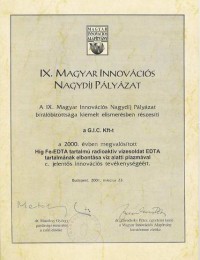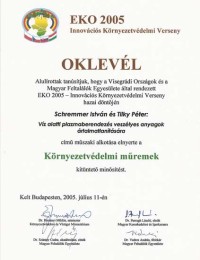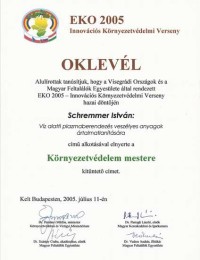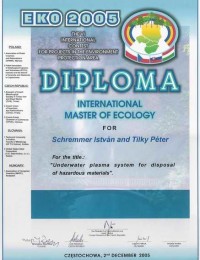Underwater plasma technology (UWPT) is a brand new, unique in the world oxidation technology, which allows decomposition of the organic content of waste waters, be they dissolved or be they present in colloid form. Decomposition of the organic pollutants takes place directly inside the aquous solution or inside the emulsion, in a termic electric plasma zone that is generated by instantenous discharges of super capacitors created by the applied electricity on the surface of the submerging electrode/electrodes.
One of the major benefits of the technology is that in course of the purification process, the water content of the waste water does not need to be evaporated, therefore, the energy consumption of the process is much lower than that of the traditional combined distillation-incineration processes.
From an energetics point of view, compared to traditional plasma technologies, UWPT offers other benefits, as well:
- The water to be treated does not need to be ionized. In case of ionizing plasma methods, during the recombination of the generated ions unwanted toxic materials, e.g. hydrogen cyanide or dioxins may be generated, that are very difficult to wash out from the exhaust gases.
- In the course of the decomposition of organic materials mostly carbon dioxide, nitrogen and water are formed, while the inorganic salt content of the solution remains unchanged.
- In many cases, it is enough to continue the underwater plasma treatment up to a point where the organic toxicity of the waste water is removed, hence biological waste water treatment becomes possible again.
- Halogen, sulphur and phosphor containing organics can be decomposed, too.
- During underwater plasma treatment there is no need for the addition of flocculants.
Applying underwater plasma technology, the chemical oxygen demand (COD) of waste waters can be decreased to virtually zero. Oxidation is carried out by the strongly oxidizing free radicals that are generated by the plasma. Our technology can be applied when the waste water is conductive or can be turned conductive, which condition is satisfied in almost all cases.
Basics of the technology were invented by István Schremmer in the early seventies. In the late nineties, together with inventor friend Péter Tilky he developed apparatuses that are suitable for industrial applications. The invention was patented in 2001, at first in Hungary („Method and equipment for decomposition organic contents of watery effluents under water”, Hungarian patent registration number: 224394).
The researchers creed of István Schremmer is the necessity for continuous improvement and development, therefore, he is improving the technology further within the framework of his new company: SCHREMMER SOLUTIONS Co Ltd.
1,6 MW underwater plasma device for decomposing aquous 60Co-EDTA complex. Operated at Paks Nuclear Power Plant.

Félüzemi kísérleti berendezés, mely a Dél-Koreai Villamosipari Kutatóintézet (KEPRI) számára készült.
The electric plasma zone is formed on the surface of submerging electrodes, due to the effect of alternating current. Because of applying at least 10 Hz frequency alternating current, electrochemical reactions cannot take place, hence oxyhydrogen (a mixture of hydrogen and oxygen gas) is not generated. The organic components of the waste water are decomposed by the joint effect of extreme high temperature and UV radiation of the plasma, and especially, by the free OH radicals that are generated in the plasma zone. Efficiency of the decomposition can be further intensified by additioning radical-forming oxidizing agents, e.g. hydrogen-peroxide. Applying underwater plasma technology, the decomposition of the organic materials is achieved by breaking atom-atom bonds; at this point underwater plasma technology differs from traditional gas phase plasma applications where complete atomization of the molecules happens.
When applying underwater plasma technology, the water content of the liquid waste is not evaporated, therefore, the energy consumption of the process is much lower compared to distillation-based processes. Naturally, the energy consumption of the treatment depends on the type and capacity of the underwater plasma device as well as on the initial and required final compositions of the actual liquid waste. Energy consumption of a 50 Hz underwater plasma equipment is about 0.9 kW*hr/m3 waste water, when an initial COD of 10,000 mg/L is decreased to 100 mg/L. The current direction of the development of the technology has a twofold purpose: reducing this energy consumption to a great extent, and speeding up the decomposition process.
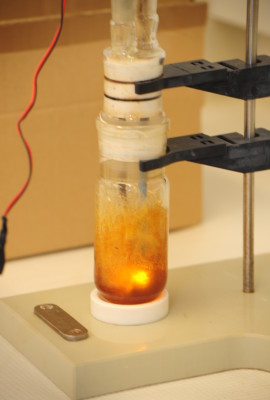
Paks Nuclear Power Plant (Hungary)
Removal of the EDTA content of Fe-EDTA solutions. Fe-EDTA containing boric acid waste solutions are generated during the cleaning of the primary loop steam generators of nuclear power plants. The G.I.C. Ltd. treated successfully 2000 cubic meters of such radioactive waste until the end of year 2000.
Removal of Co-60 isotope from boric acid containing radioactive concentrates, by decomposing the Co-EDTA organic complex, and by filtering out the precipitating cobalt-hydroxide. Initial Co-60 radioactivity of the solution was 20,000 Bq/L, which was decreased to under 100 Bq/L. Underwater plasma technology is an important element of the complex liquid radioactive waste treatment technology of Paks NPP that allows radical reduction of the volume of the routinely generated liquid radioactive waste. Due to the volume reduction, disposal costs of the radioactive waste are reduced radically, too.

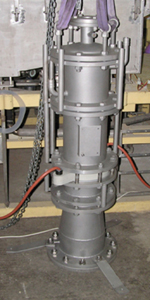
MOL Oil Refinery, Százhalombatta (Hungary)
Removal of the mercaptan content of a caustic MEROX liquid. Initial chemical oxygen demand (COD) of the liquid was 200,000 mg/L, which was decreased to less than 50 mg/L via applying underwater plasma technology.
Removal of methyl alcohol from waste waters at the same industrial site. Initial COD: 20,000 mg/L, COD after underwater plasma treatment: 50 mg/L. The underwater plasma equipment is used as a back-up solution for the case of emergency spills.
< Submersible underwater plasma device for cleaning methanol containing waste waters. Operated at MOL Hungarian Oil Company. The mobile device can be used in open air basins.
CIPLA gyógyszergyár, India
Cleaning of a complex pharmaceutical waste water. Initial COD: 5800 mg/L. Due to the underwater plasma treatment, the COD of the wastewater dropped to under the detection limit, so practically to zero.
Removal of nitrophenols from an arms industry wastewater
Total initial nitrophenol content of the wastewater was 6524 ppm. The plasma treatment completely eliminated the nitro phenol content of the wastewater.
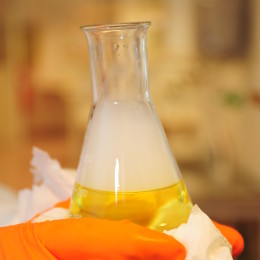
- Nuclear power plants
- Nuclear industry in general
- Petroleum industry
- Chemical industry
- Pharmaceutical industry
- Food industry
- Environmental protection industry
- Waste incinerators (liquid wastes)
- Chemical and pharmaceutical laboratories
- Special laboratories for the destruction of biological and chemical weapons
- Hazardous waste treatment units of hospitals and clinics
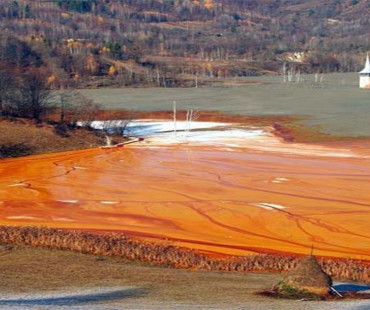

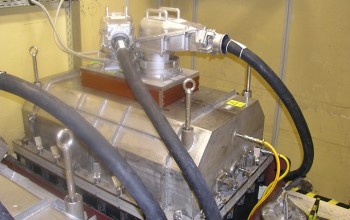

Honourable mention of the XIVth Hungarian Prize of Innovation, 2006; „For the innovation titled LWG-101-25 type mobile underwater plasma apparatus”
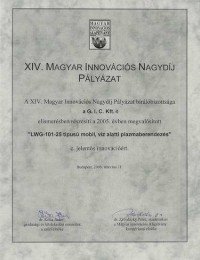
Extra Award of the IXth Hungarian Prize of Innovation; „Decomposition of EDTA content of diluted Fe-EDTA complex containing radioactive waste water using underwater plasma”
